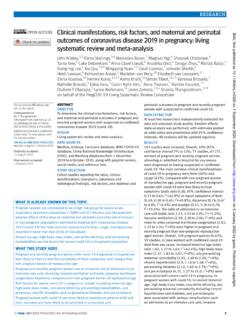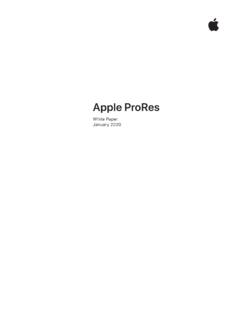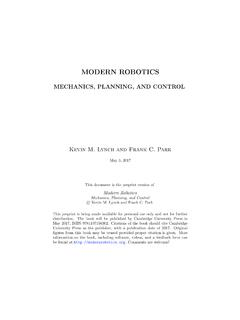Transcription of MEMORY STORAGE CALCULATIONS - Rutgers University
1 1/29/2007 CALCULATIONS Page 1 MEMORY STORAGE CALCULATIONS Professor Jonathan Eckstein (adapted from a document due to M. Sklar and C. Iyigun) An important issue in the construction and maintenance of information systems is the amount of STORAGE required. This handout presents basic concepts and CALCULATIONS pertaining to the most common data types. BACKGROUND - BASIC CONCEPTS Grouping Bits - We need to convert all MEMORY requirements into bits (b) or bytes (B). It is therefore important to understand the relationship between the two. A bit is the smallest unit of MEMORY , and is basically a switch. It can be in one of two states, "0" or "1". These states are sometimes referenced as "off and on", or "no and yes"; but these are simply alternate designations for the same concept.
2 Given that each bit is capable of holding two possible values, the number of possible different combinations of values that can be stored in n bits is 2n. For example: 1 bit can hold 2 = 21 possible values (0 or 1) 2 bits can hold 2 2 = 22 = 4 possible values (00, 01, 10, or 11) 3 bits can hold 2 2 2 = 23 = 8 possible values (000, 001, 010, 011, 100, 101, 110, or 111) 4 bits can hold 2 2 2 2 = 24 =16 possible values 5 bits can hold 2 2 2 2 2 = 25 =32 possible values 6 bits can hold 2 2 2 2 2 2 = 26 = 64 possible values 7 bits can hold 2 2 2 2 2 2 2 = 27 = 128 possible values 8 bits can hold 2 2 2 2 2 2 2 2 = 28 = 256 possible values M n bits can hold 2n possible values M Bits vs.
3 Bytes - A byte is simply 8 bits of MEMORY or STORAGE . This is the smallest amount of MEMORY that standard computer processors can manipulate in a single operation. If you determine the number of bits of MEMORY that are required, and divide by 8, you will get the number of bytes of MEMORY that are required. Similar, to convert from bytes to bits, you must multiply by 8. Standard Datatypes - Many standard kinds of data occupy either 1, 2, 4, or 8 bytes, which happen to be the data sizes that today s typical processor chips are designed to manipulate most efficiently. 1 byte = 8 bits: o A single character of text (for most character sets). Thus, an MS Access field with datatype Text and field width n consumes n bytes.
4 Example: Text(40) consumes 40 bytes. o A whole number from 128 to +127. This is what you get in the MS Access Number/Byte datatype o A whole number from 0 to 255 o MS Access Yes/No fields also consume 1 byte. In principle, you only need a single bit, but one byte is the minimum size for for a field. 2 bytes = 16 bits, or two bytes: o A whole number between about 32,000 and +32,000; this is MS Access Number/Integer datatype, often also called a short integer o A single character from a large Asian character set 4 bytes = 32 bits: o Can hold a whole number between roughly 2 billion to +2 billion. This is MS Access Number/Long Integer datatype o A single precision floating-point number. Floating point is basically scientific notation, although the computer s internal representation uses powers of 2 instead of powers of 10.
5 1/29/2007 CALCULATIONS Page 2 This is MS Access Number/Single datatype, with the equivalent of about 6 decimal digits of accuracy. 8 bytes = 64 bits: o Can hold a double precision floating-point number with the equivalent of about 15 digits of accuracy. This is MS Access Number/Double datatype, and is the most common way of storing numbers that can contain fractions. o Really massive whole numbers (in the range of + or 9 quintillion). This is essentially the way MS Access stores the following datatypes Date/Time Currency. Multiplier Prefixes - MEMORY requirements can become huge, and standard metric-system prefixes are utilized to keep the ultimate value manageable, according to the usual metric system: 1 kilobit (kb) or kilobyte (kB) = 1000 bits or 1000 bytes, respectively 1 megabit (Mb) or megabyte (MB) = 1000 kilobits or 1000 kilobytes, respectively 1 gigabit (Gb) or gigabyte (GB) = 1000 megabits or 1000 megabytes, respectively 1 terabit (Tb) or Terabyte (TB) = 1000 gigabits or 1000 gigabytes, respectively Because computers tend to work in powers of 2, computer engineers have taken liberty with the above by substituting the multiplier 1024 (= 210) for 1000.
6 As a result, for many applications: 1 kilobit (kb) or kilobyte (kB) = 1024 bits or 1024 bytes, respectively 1 megabit (Mb) or megabyte (MB) = 1024 kilobits or 1024 kilobytes, respectively 1 gigabit (Gb) or gigabyte (GB) = 1024 megabits or 1024 megabytes, respectively 1 terabit (Tb) or Terabyte (TB) = 1024 gigabits or 1024 gigabytes, respectively We ll call these two different systems decimal-style and binary-style , respectively. Which one gets used depends on the convention for marketing or measuring a particular component. When you buy a 128 MB RAM chip for a computer, you actually get 128 binary megabytes, or about million (128 MB x 1024 KB/MB x 1024 B/KB). Your computer BIOS will read the RAM as 128 MB ( / ( x ).)
7 When you buy a 15 GB hard drive, however, you might well get 15 decimal gigabytes, so when the drive is formatted, your computer's operating system might state its size as binary GB (15 / ( x x )). You haven't lost 1 GB; the size was measured using two different systems. DETERMINING MEMORY REQUIREMENTS FOR A SINGLE UNIT Each type of data has its own specialized name for its "unit", as follows: Numeric data is typically stored stored in the following standard formats (see above) o Byte (8 bits/1 byte): whole numbers from 0 to 255, or 128 to +127 o Short (16 bits/2 bytes), or what Access calls integer : whole numbers from approximately 32,000 to +32,000 o Long integer (32 bits/4 bytes): whole numbers from approximately 2 billion to +2 billion o Single: or float (32 bits/4 bytes): scientific notation numbers with approximately 6 digits of precision o Double or double precision (64 bits/8 bytes).
8 Scientific notation numbers with approximately 15 digits of precision For textual data, a unit is a "character"; a file consists of a number of characters. For picture data, a unit is a "dot" or "pixel"; a file consists of a number of dots or pixels. For sound data, a unit is a "sample"; a file consists of a number of samples. For video data, a unit is a " frame "; a file consists of a number of frames (each frame is a picture) 1/29/2007 CALCULATIONS Page 3 Despite the different names, the manner by which we calculate the MEMORY requirements of a "unit" of data is similar. TEXTUAL DATA - UNIT SIZE The STORAGE requirement for a single character (letter, number, punctuation mark, and symbol) depends upon the size of the character set used.
9 Each character have a unique representation, so the larger the character set, the larger the MEMORY requirement for each character in the set. Early character sets (containing 26 capital letters, 10 numbers, a space character, and assorted punctuation) allowed 64 characters. A popular example is ASCII 64 . These sets require 6 bits per character. Because of the need to include punctuation and/or special symbols in the character set, 6-bit character sets cannot differentiate between small and capital letters, and are now virtually unused. Current western character sets contain either 128 or 256 characters, requiring either 7 or 8 bits per character. Each is typically stored in one byte (even if only 7 bits are used).
10 There are two standards for representing characters, ASCII (used most places) and EBCDIC (used only on some mainframe equipment of older design). In ASCII, for example, the character 3 is represented by 00110011, A by 00100001, b by 01100010, and $ by 00100100. Markup information like font family, bold, italic, and so forth must be represented separately it is not part of the basic 128/256 character set Some Asian character sets have space for as many as 64K characters, requiring up to 16 bits per character. PICTURE DATA - UNIT SIZE These days, most picture data is represented in raster or bitmap format a rectangular array of dots, each with its own color. For picture files, the concepts of "dots" and "pixels" are identical.







